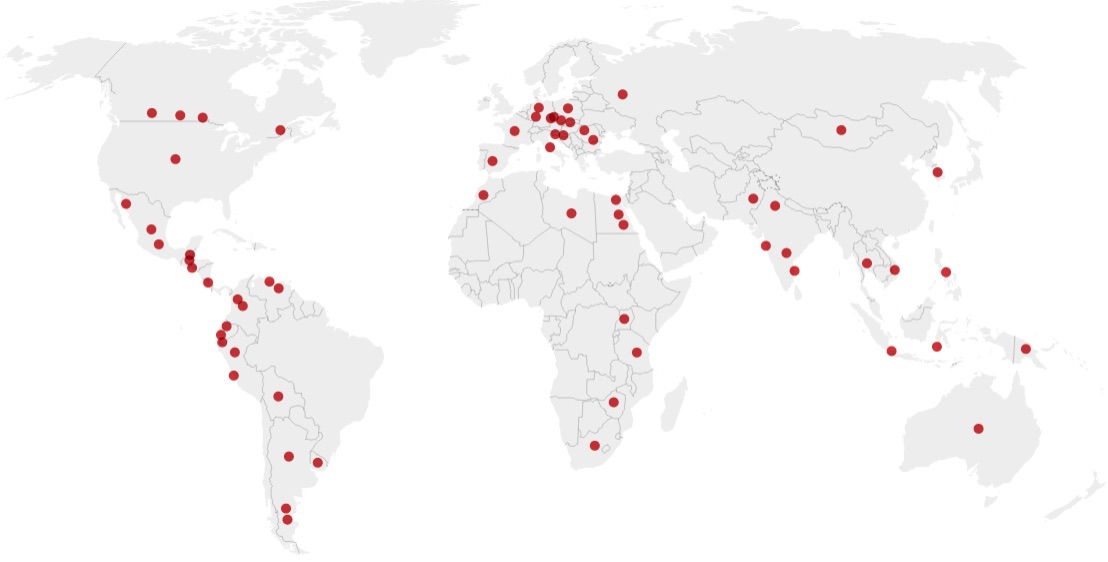Verfassungsblog | 19 November 2023
Undermining the energy transition
by Julia Dehm
Julia Dehm is a Senior Lecturer at La Trobe Law School, Australia.
Australia is confronted with three multi-billion dollar investment treaty claims from a mining company. The basis for two of the claims is a judgment from the Queensland Land Court, in which the court recommended that no mining lease and environmental authority should be granted to a subsidiary of the claimant for its coal mine. The investment treaty arbitration serves as another illustration of how the international investment protection system poses a threat to an urgent and just energy transition. In this blog post, I explain the background of the investment treaty claim, the decision of the Queensland Land Court, and argue that the Court’s decision is an important precedent for the connection between coal, climate change, and human rights.
Linking Climate Change and Human Rights
In a decision widely hailed as “historic” and “landmark”, the Queensland Land Court, in the case of Waratah Coal Pty Ltd v Youth Verdict Ltd, recommended the refusal of an environmental authority and mining lease applications for a coal mine project. This was in part because the mine’s contribution to climate change would undermine human rights. Following the decision from November 2022, the Queensland Department of Environment and Science refused the environmental authority for the mine. While the company initially appealed, it withdrew this appeal in February 2023. In May 2023, Australian mining magnate Clive Palmer’s Singapore-based company, Zeph Investments Pty Ltd (which owns 100% of Waratah Coal) filed a notice of arbitration against Australia under Chapter 11 of the ASEAN-Australia-New Zealand Free Trade Agreement, seeking $43 billion in damages for the refusal of environmental permits for the mine. In October 2023, Zeph Investments Pty Ltd filed a further notice of intention to commence arbitration against the Australian government under the Singapore-Australia Free Trade Agreement, seeking $69 billion in damages. This notice alleges, amongst other claims, that the decision of the Land Court breached the minimum standard of treatment required under the fair and equitable treatment clause of the Agreement and constituted an expropriation.
These cases highlight how investment treaties pose a real risk to a rapid transition away from fossil fuels and increase the costs of the energy transition. In a recent report, the United Nations Special Rapporteur on human rights and the environment provided compelling evidence of how ISDS has “become a major obstacle to the urgent actions needed to address the planetary and human rights crises”, concerns also echoed by the Intergovernmental Panel on Climate Change (IPCC). Analysis in Science documented that to date, there have been at least 231 ISDS cases related to fossil fuel investment (with 72% success rates for fossil fuel investors). Governments around the world could face exposure to claims from fossil fuel investors amounting to $340 billion.
The Queensland Land Court’s decision was the first case in Australia to explicitly link climate change and human rights and is arguably one of the few cases globally where the links between expanding fossil fuel production, its impacts on climate change, and the resulting effects on human rights have been recognized. There is growing scientific evidence, including in the IPCC AR6 Synthesis Report and the International Energy Association’s modelling, that in order to limit warming to 1.5°C, there can be no new fossil fuel infrastructure, and there needs to be a rapid phase-out of existing infrastructure. Yet the alarming reality is, as the Production Gap report shows, that governments around the world are planning to produce double the amount of fossil fuels that would be consistent with limiting warming to 1.5°C. Australia is already the third largest exporter of fossil fuel globally; it is one of the countries with the biggest expansion plans as well as one of the highest subsidizers of fossil fuels.
Additionally, there is now a consensus that climate change threatens the realisation of all human rights and will have a “cataclysmic” impact on the realisation of rights unless more ambitious action is urgently taken. In recent years there has been a “rights turn” in climate litigation, with now over 121 decided or pending cases that utilised human rights arguments to advance climate mitigation or adaptation (for an overview see here and here). However, there remains a real “supply-side accountability gap”. Some human rights treaty bodies and special procedure mandate holders have offered views on the role of fossil fuel production. Arguably, this is starting to coalesce into a clear normative position that preventing new fossil fuel developments is necessary to protect, respect, and fulfil the realisation of all human rights.
Burning Coal, Violating Rights
The proposed Waratah Coal mine project, proposed for both open cut and underground thermal coal mining, is located north of Alpha in Central Queensland. The project would impact several properties, including a privately owned protected area, the Bimblebox Nature Refuge. It was intended that the coal extracted from this mine would be exported to countries in southeast Asia for electricity generation. The mine, if approved, would have extracted 40 million tonnes of coal per year, producing 1.58 billion tonnes of carbon dioxide emissions over its lifetime.
The Queensland Land Court, under the applicable legislative framework governing mining in Queensland – including the Mineral Resources Act 1989 (Qld) and the Environmental Protection Act 1994 (Qld) – was tasked with hearing an application for a mining license and environmental authority and made recommendations to the final decision maker. The objectors in this case, including Youth Verdict, a coalition of young people from across Queensland, represented by public interest environmental lawyers, the Environmental Defenders Office, argued that the recently enacted Human Rights Act 2019 (Qld) was relevant to these proceedings, given that the Queensland Land Court, as a ‘public entity’ has obligations under the Act, including to make a decision in a way that is compatible with human rights and to give proper consideration to human rights in making its decision. Thus, although the Human Rights Act does not provide an independent cause of action, rights considerations could thereby be “piggy backed” onto an existing cause of action, such as an administrative appeal.
Youth Verdict argued that the project would infringe upon a multitude of rights protected by the Human Rights Act 2019 (Qld). These rights included the right to life of people in Queensland, the rights of First Nations peoples, the rights of children, the right of property of the people in Queensland, and the right of certain groups to enjoy human rights without discrimination. Waratah Coal, however, argued that the emissions caused by the burning of the coal were not a relevant consideration for the court, as the responsibility for emissions caused from the combustion of the coal rests with the country where the coal is burnt.
The decision by President Kingham, spanning 372 pages, is incredibly careful in its consideration of the extensive evidence before the court, including detailed deliberations of how to engage climate scenarios and models, economic models about the pricing and demand for coal, and the political questions that structure the various assumptions that go into a cost-benefit analysis. Kingham P dismissed arguments made by Waratah Coal that there was too much uncertainty to predict what will happen with climate change, affirming that “there is sufficient certainty in the science to understand the relationship between emissions and temperature” [28]. In considering the impacts of the emissions from the mine, she considered the carbon budget approach “helpful” and found that the 1.58GtCO2 resulting from the mine between 2029 and 2051 would make a “material contribution” to the remaining carbon budget (which expert evidence showed was 320Gt to limit warming to 1.5°C or 620GtCO2 to limit warming to 2°C). While Waratah Coal tried to argue that Scope 3 emissions should not be considered by the court, relying in part on arguments that the Paris Agreement was based on a territorially bounded system of reporting of GHG emissions, Kingham P affirmed that scope 3 emissions were a relevant consideration.
Most significantly, Kingham P also rejected the so-called “market substitution defense” raised by Waratah Coal. The company argued that approving the mine would make no difference to global emissions because other coal – perhaps of lesser quality and higher carbon intensity – would simply be extracted from elsewhere to meet demand. This argument has been relied on by the fossil fuel industry in climate litigation in Australia and applied in several Queensland cases. However, it has been strongly criticised by legal academics. Kingham P characterized substitution as a “factual not a legal question” [793], noting that “there is a vast difference between accepting the relevance of the possibility of perfect substitution and assuming it will occur” [793]. She then proceeded to carefully consider expert evidence, including on the dynamics of supply and demand in international coal markets, before concluding that “the evidence about the perfect substitution proposition does not satisfy me the mine would have no bearing on GHG emissions” [1026].
This case should be of international interest for scholars of both human rights and climate litigation because of its careful engagement with the relationship between human rights and the extraction and burning of coal. After a detailed discussion of the relevant legislative tests, and international human rights jurisprudence (which was considered a ‘useful source of analogical reasoning’ even though it must be ‘approached with caution’ when considering the scope of rights and whether they were limited by the project [1354]), Kingham P found that approving the mine would cause climate change impacts, would limit several rights including the right to life, the cultural rights of First Nations peoples, the rights of children, the right to property and to privacy and home and the right to enjoy human rights equally. She thus concluded that the “balance weighs against approving the applications” [1655] and that “the importance of preserving the human rights is more important than the purpose of the Protect” [1657].
Given the careful and meticulous analysis conducted by Kingham P, it is concerning that the notice of intent to commence arbitration argues that the decision of the Queensland Land Court “was contrary to established precedent and jurisprudence, replete with error, illogicality, unreasonableness and involved findings of fact and law made to fit a predetermined and prejudicial outcome.” The notice also seeks to question the impartiality of President Kingham, describing her as “a political appointee with an anti-coal, pro-climate change activist agenda”, citing evidence that she has previously “publicly expressed her support for the extremist climate change action organisation ‘Extinction Rebellion’” on social media. It also alleges improper interactions between the Queensland Land Court and the lawyers from the Environmental Defenders Office. It thus seeks to present an image of Australia as a state that does not provide mining companies with basic rule of law protections, when academic studies have shown the opposite: that fossil fuel and resource extraction industries have “constructed a covert network of lobbyists and revolving door appointments which has ensured that industry interests continue to dominate Australia’s energy policy”.
A Precedent and a Warning
The Australian government said other legal action by Zeph Investments Pty Ltd would be “vigorously defended” and the governing Australian Labour Party (ALP) has a policy to “review ISDS provisions in existing trade and investment agreements and seek to work with Australia’s trading partners to remove these provisions”. However, even if this arbitration (brought by someone considered by some a “vexatious litigant”), that is likely to be challenged on jurisdictional grounds, is not ultimately successful, such investment arbitration can still have a “chilling effect” at a time when a much more rapid transition away from fossil fuels is urgently needed. Waratah Coal v Youth Verdict is thus both an important international precedent about coal, climate change and human rights, but also an important warning about how international arbitration risks undermining urgent and just energy transition.


